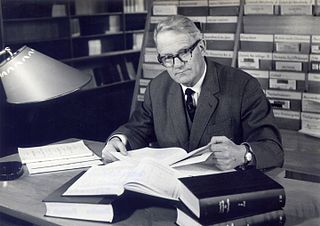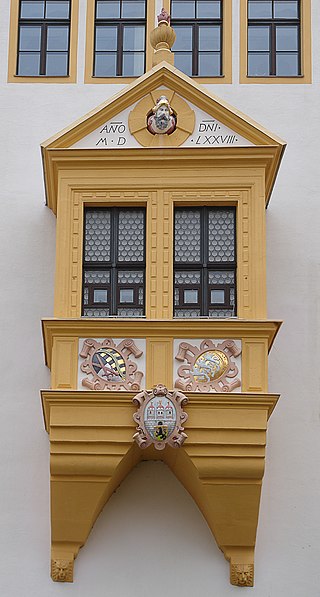Related Research Articles

The charge at Krojanty, battle of Krojanty, the riding of Krojanty or skirmish of Krojanty was a Polish cavalry charge on the evening of 1 September 1939, the first day of the Second World War, near the Pomeranian village of Krojanty. It occurred at the start of the invasion of Poland and was part of the larger Battle of Tuchola Forest. Polish soldiers advanced east along the railway to a railroad crossroads 7 kilometres (4.3 mi) from the town of Chojnice, where elements of the Polish cavalry charged and dispersed a German infantry battalion. Machine gun fire from German armoured cars that appeared from a nearby forest forced the Poles to retreat. However, the attack delayed the German advance, allowing the Polish 1st Rifle Battalion and Czersk Operational Group to withdraw safely.

Gustav Freytag was a German novelist and playwright.

The Federal Intelligence Service is the foreign intelligence agency of Germany, directly subordinate to the Chancellor's Office. The BND headquarters is located in central Berlin. The BND has 300 locations in Germany and foreign countries. In 2016, it employed around 6,500 people; 10% of them are military personnel who are formally employed by the Office for Military Sciences. The BND is the largest agency of the German Intelligence Community.

The 3.7 cm ÚV vz. 38, manufacturer's designation Škoda A7, was a 37 mm tank gun designed by the Skoda Works in Czechoslovakia prior to World War II.

Carl Friedrich Freiherr von Weizsäcker was a German physicist and philosopher. He was the longest-living member of the team which performed nuclear research in Nazi Germany during the Second World War, under Werner Heisenberg's leadership. There is ongoing debate as to whether or not he and the other members of the team actively and willingly pursued the development of a nuclear bomb for Germany during this time.

Nazi Germany undertook several research programs relating to nuclear technology, including nuclear weapons and nuclear reactors, before and during World War II. These were variously called Uranverein or Uranprojekt. The first effort started in April 1939, just months after the discovery of nuclear fission in Berlin in December 1938, but ended only a few months later, shortly ahead of the September 1939 German invasion of Poland, for which many notable German physicists were drafted into the Wehrmacht. A second effort under the administrative purview of the Wehrmacht's Heereswaffenamt began on September 1, 1939, the day of the invasion of Poland. The program eventually expanded into three main efforts: Uranmaschine development, uranium and heavy water production, and uranium isotope separation. Eventually, the German military determined that nuclear fission would not contribute significantly to the war, and in January 1942 the Heereswaffenamt turned the program over to the Reich Research Council while continuing to fund the activity.

"Nikolaus" Storzenbecher or "Klaus" Störtebeker was reputed to be leader of a group of privateers known as the Victual Brothers. The Victual Brothers were originally hired during a war between Denmark and Sweden to fight the Danish and supply the besieged Swedish capital Stockholm with provisions. After the end of the war, the Victual Brothers continued to capture merchant vessels for their own account and named themselves "Likedeelers". Recent studies manifest that Störtebeker was not called "Klaus" but "Johann".

In ufology, conspiracy theory, science fiction, and comic book stories, claims or stories have circulated linking UFOs to Nazi Germany. The German UFO theories describe supposedly successful attempts to develop advanced aircraft or spacecraft prior to and during World War II, further asserting the post-war survival of these craft in secret underground bases in Antarctica, South America, or the United States, along with their creators.
During the Third Rif War in Spanish Morocco between 1921 and 1927, the Spanish Army of Africa deployed chemical weapons in an attempt to put down the Berber rebellion against colonial rule in the region of Rif led by the guerrilla Abd el-Krim. Following the humiliation at the Battle of Annual in 1921, considered as the worst Spanish defeat in the 20th-century, the Spanish army pursued a vicious campaign of retribution involving the indiscriminate and routine dropping of toxic gas bombs targeting civilian populations, markets and rivers.
Rolf-Dieter Müller is a German military historian and political scientist, who has served as Scientific Director of the German Armed Forces Military History Research Office since 1999. Rolf-Dieter Müller is also a former professor of military history at Humboldt University.

Lippersdorf-Erdmannsdorf is a municipality in the district Saale-Holzland, in Thuringia, Germany.

The German Hunting and Fishing Museum is a museum exhibiting objects connected with the history of hunting and fishing in Germany or other territories which nowadays belong to it.

Josef 'Sepp' Schintlmeister was an Austrian-German nuclear physicist and alpinist from Radstadt. During World War II, he worked on the German nuclear energy project, also known as the Uranium Club. After World War II, he was sent Russia to work on the Soviet atomic bomb project. After he returned to Vienna, he took positions in East Germany. He was a professor of physics at the Technische Hochschule Dresden as well holding a leading scientific position at the Rossendorf Central Institute for Nuclear Research.

Kunz von Kaufungen was a German knight and military commander. A veteran of the Hussite wars, he also fought for Frederick II, Elector of Saxony against Frederick's brother Duke William III during the Saxon Fratricidal War (1446–1451). Afterwards, Kunz was not repaid or recognized for his services and loss of property during the war, and eventually during the Prinzenraub he kidnapped Frederick II's two sons. He was caught and later executed.

The Gäuboden is a region in Lower Bavaria in southern Germany without any clear geographic or cultural boundaries, that covers an area about 15 kilometres wide south of the River Danube and the Bavarian Forest, beginning opposite Wörth an der Donau and stretching as far as Künzing. The largest town in the region is Straubing, which is often called the centre of the Gäuboden. The Gäuboden is one of the largest loess regions in southern Germany.

The 8.8 cm SK L/45 was a German naval gun that was used in World War I and World War II on a variety of mounts.
Bote & Bock is a German publishing house founded in Berlin in 1838 by Eduard Bote and Gustav Bock (1813-1863).
Israel and the Bomb is a documentary film about nuclear weapons and Israel and policy of "nuclear ambiguity", produced and directed by Florian Hartung and Dirk Pohlmann, It was broadcast by ARTE on November 7, 2012.
Lying press is a pejorative and disparaging political term used largely for the printed press and the mass media at large. It is used as an essential part of propaganda and is thus usually dishonest or at least not based on careful research.

War of Lies is a 2014 German documentary directed by Matthias Bittner.